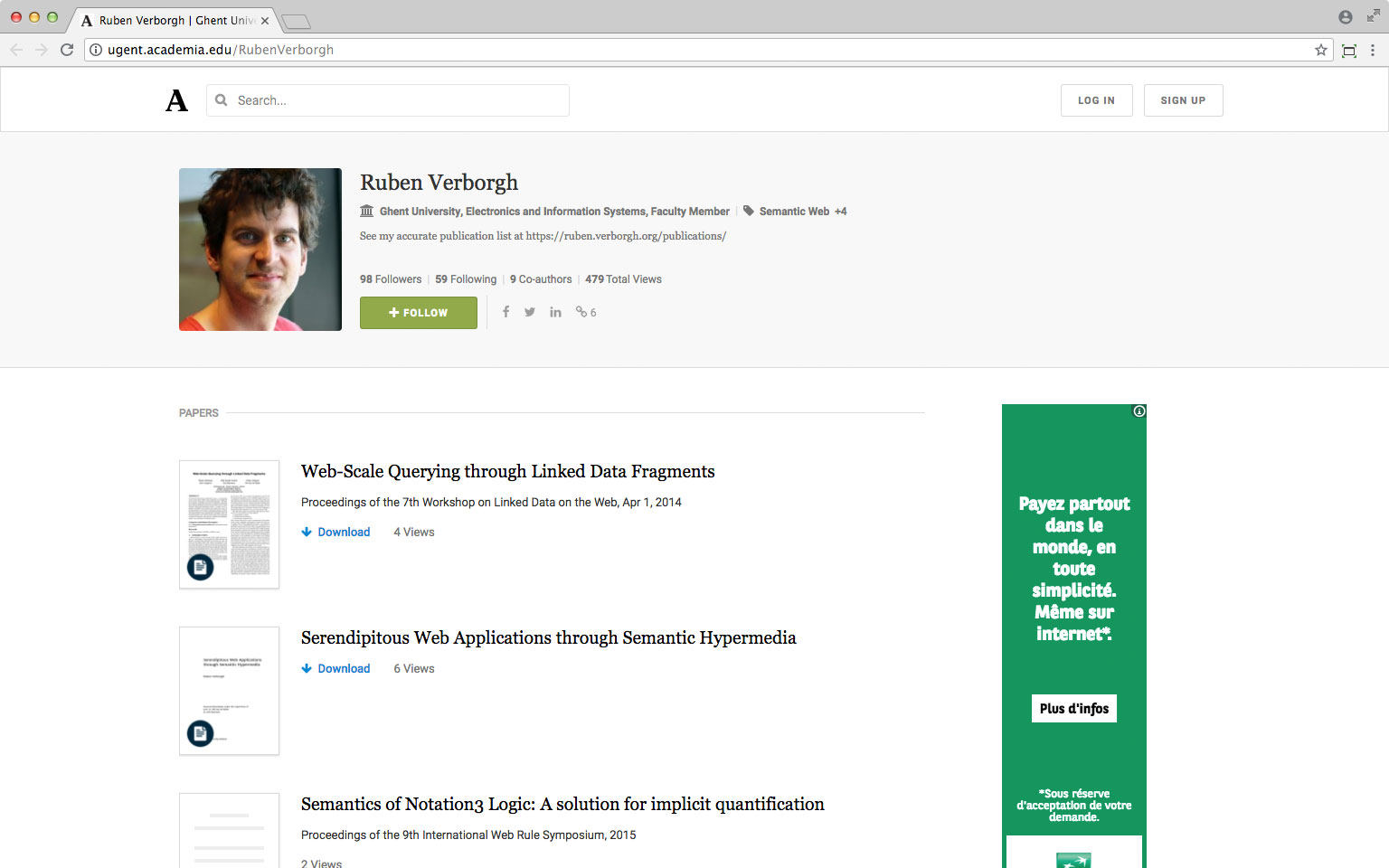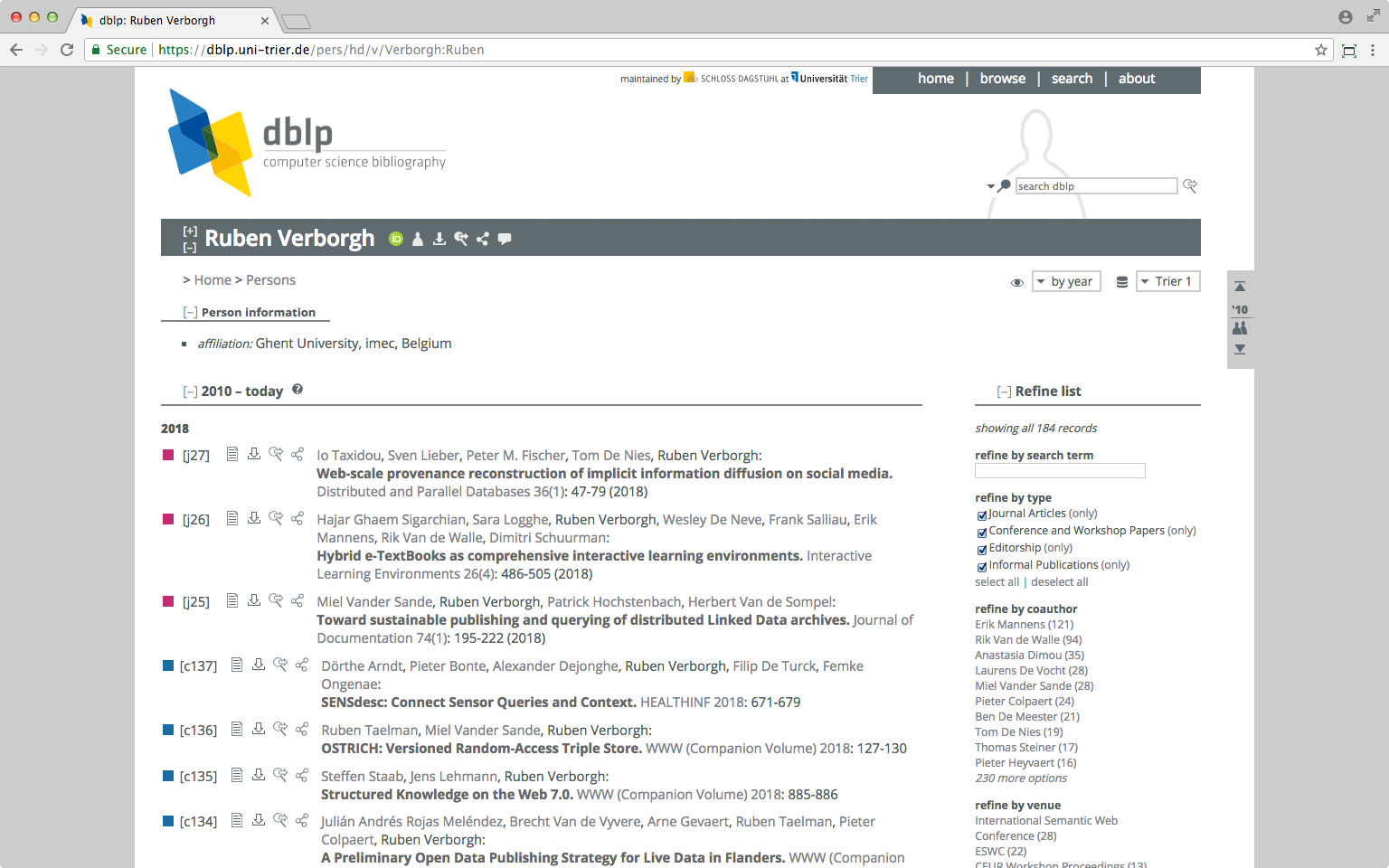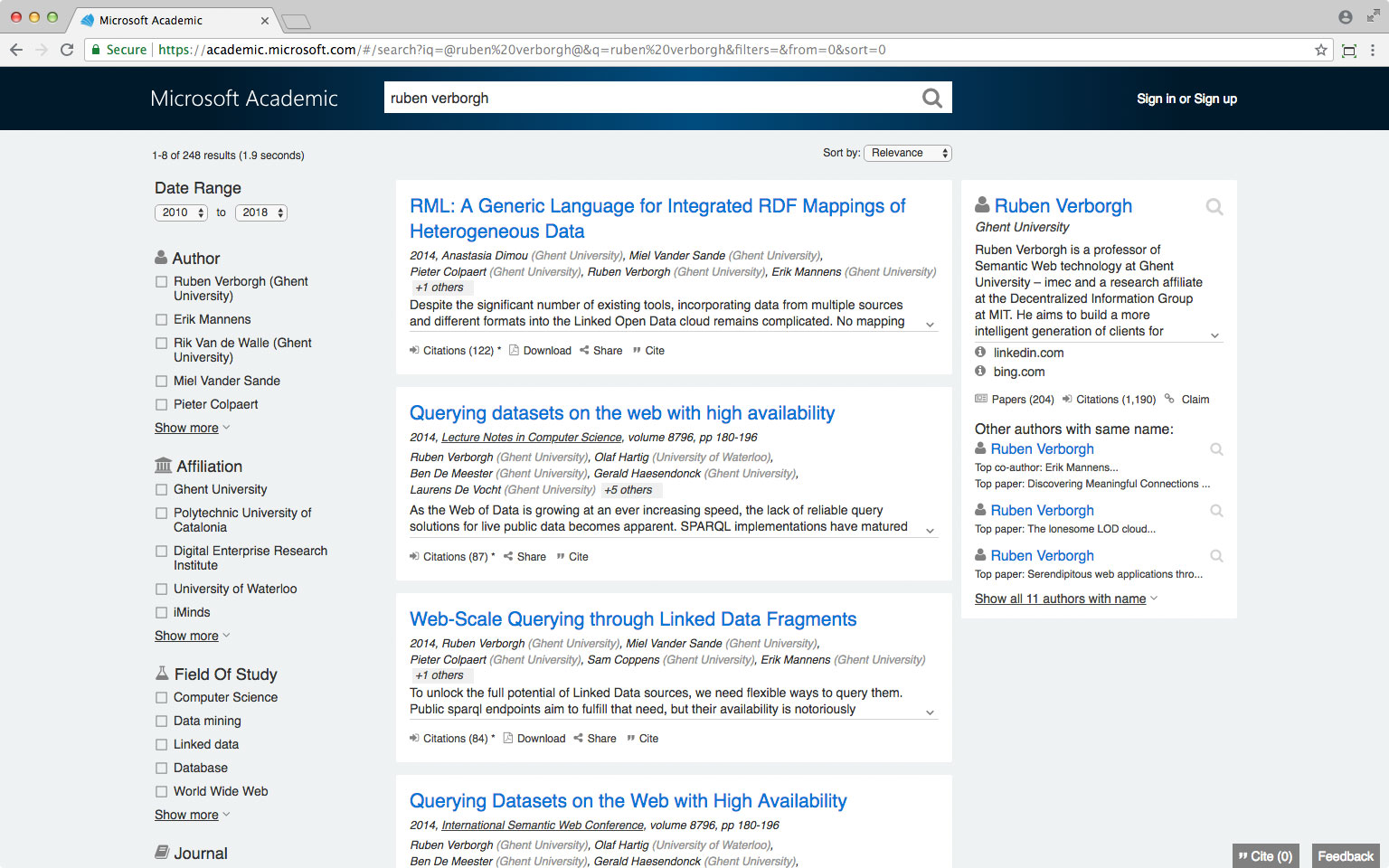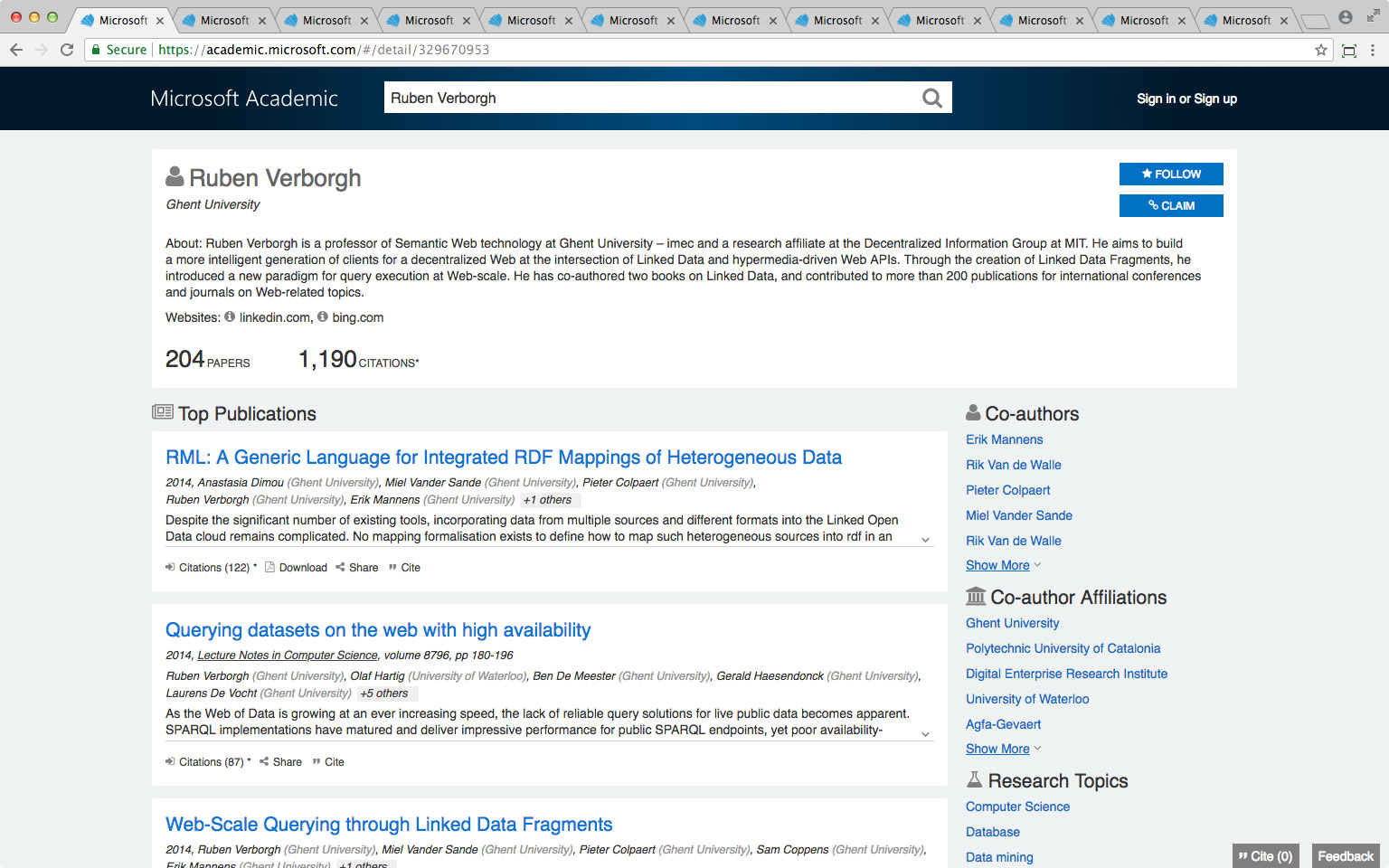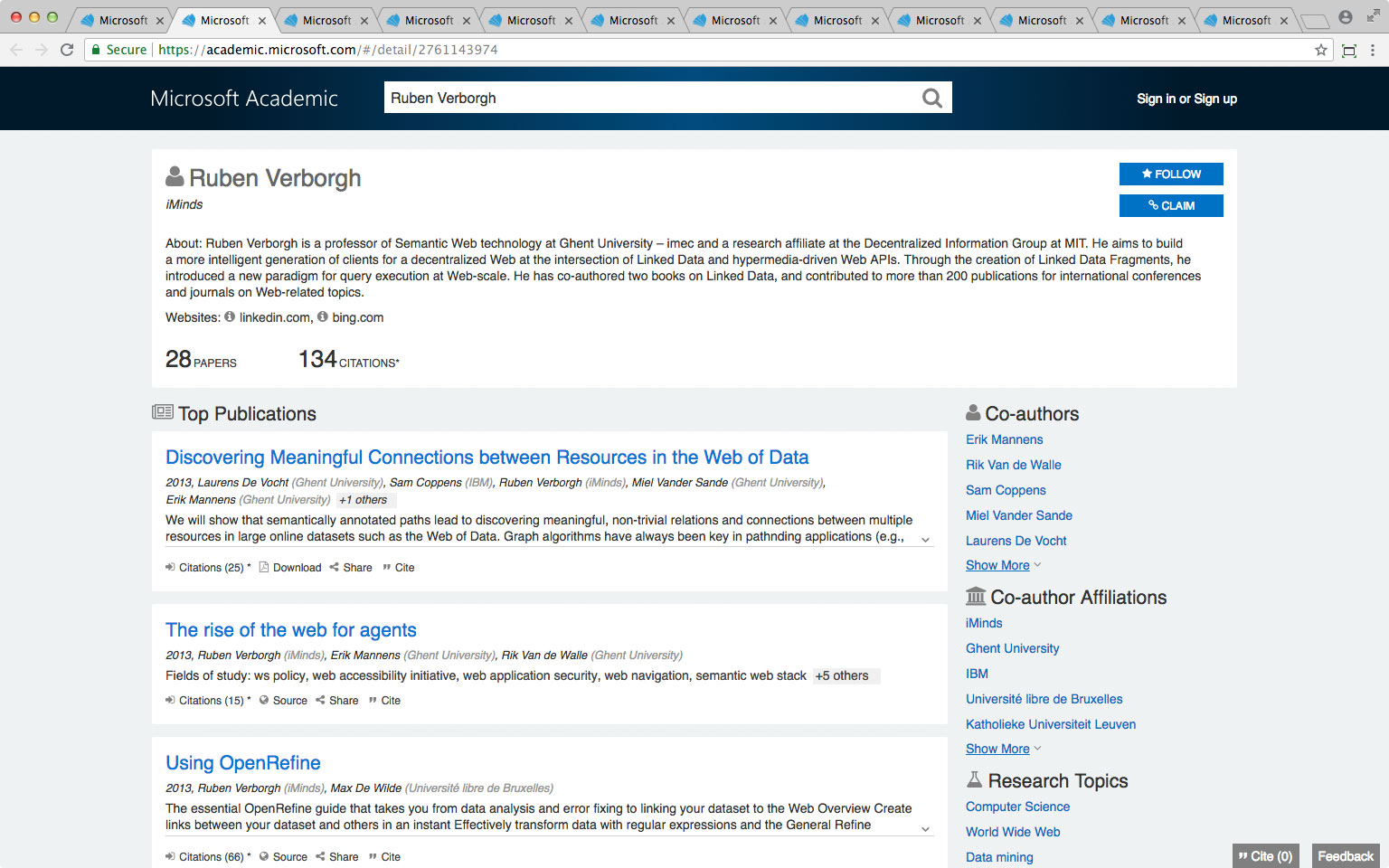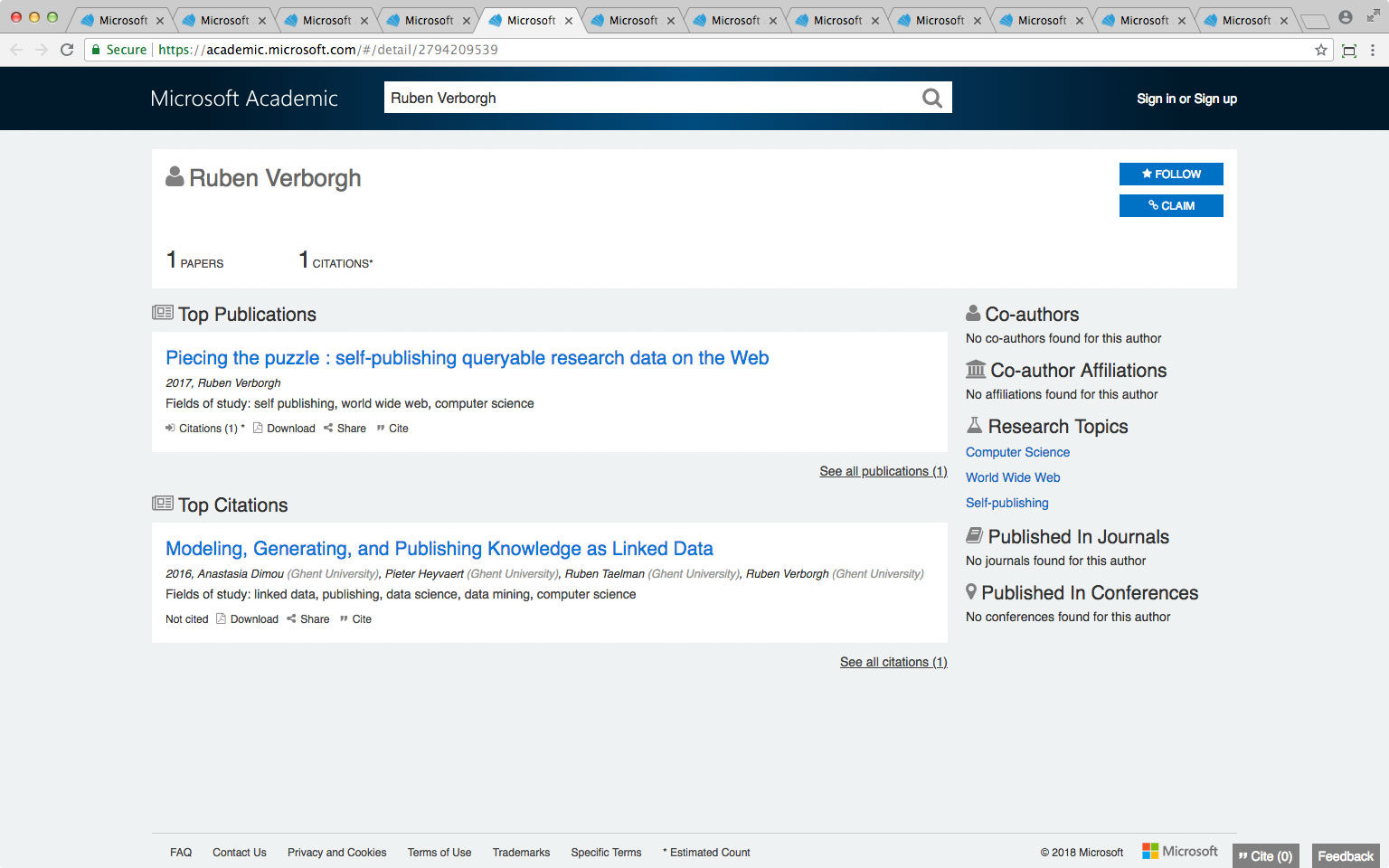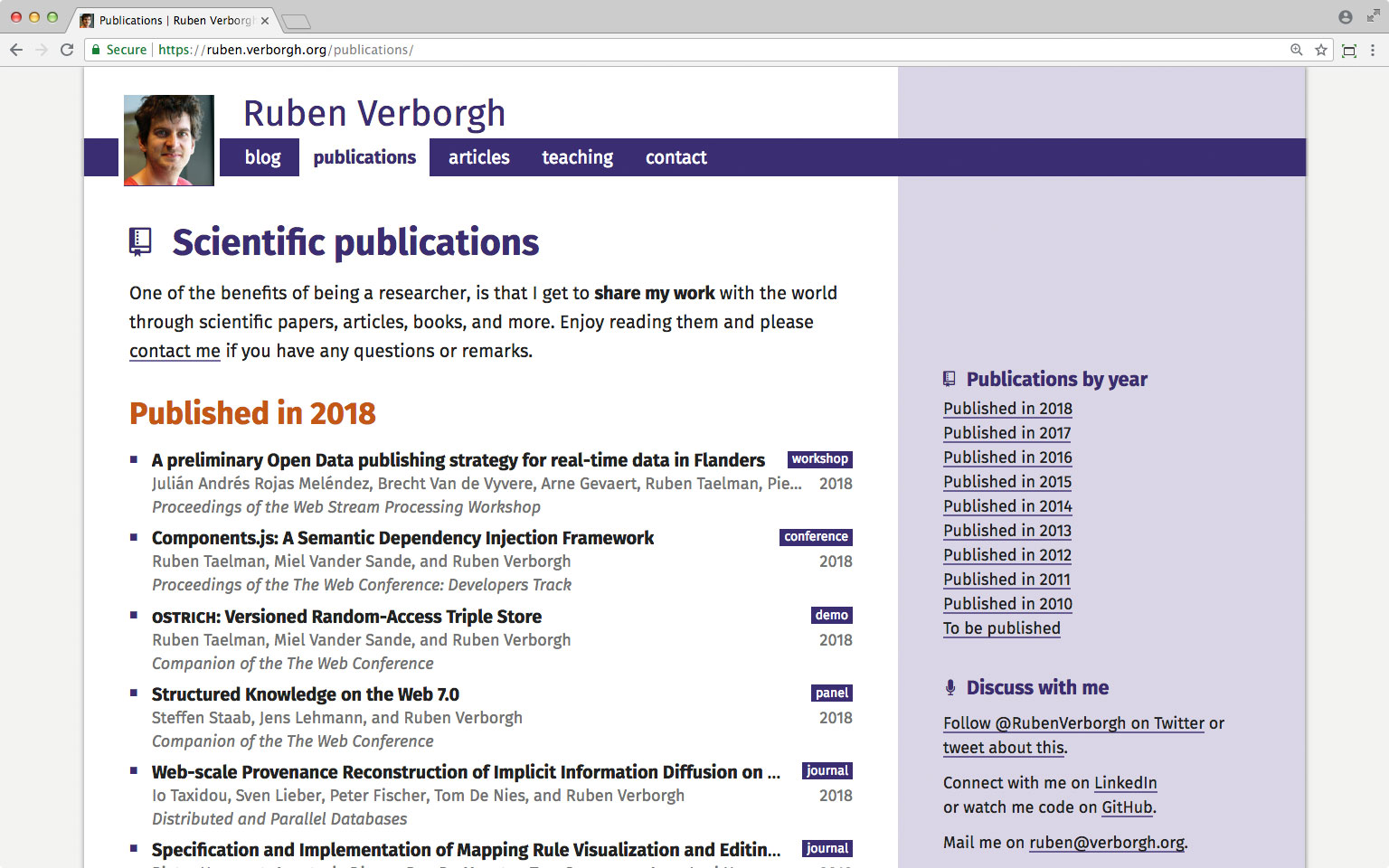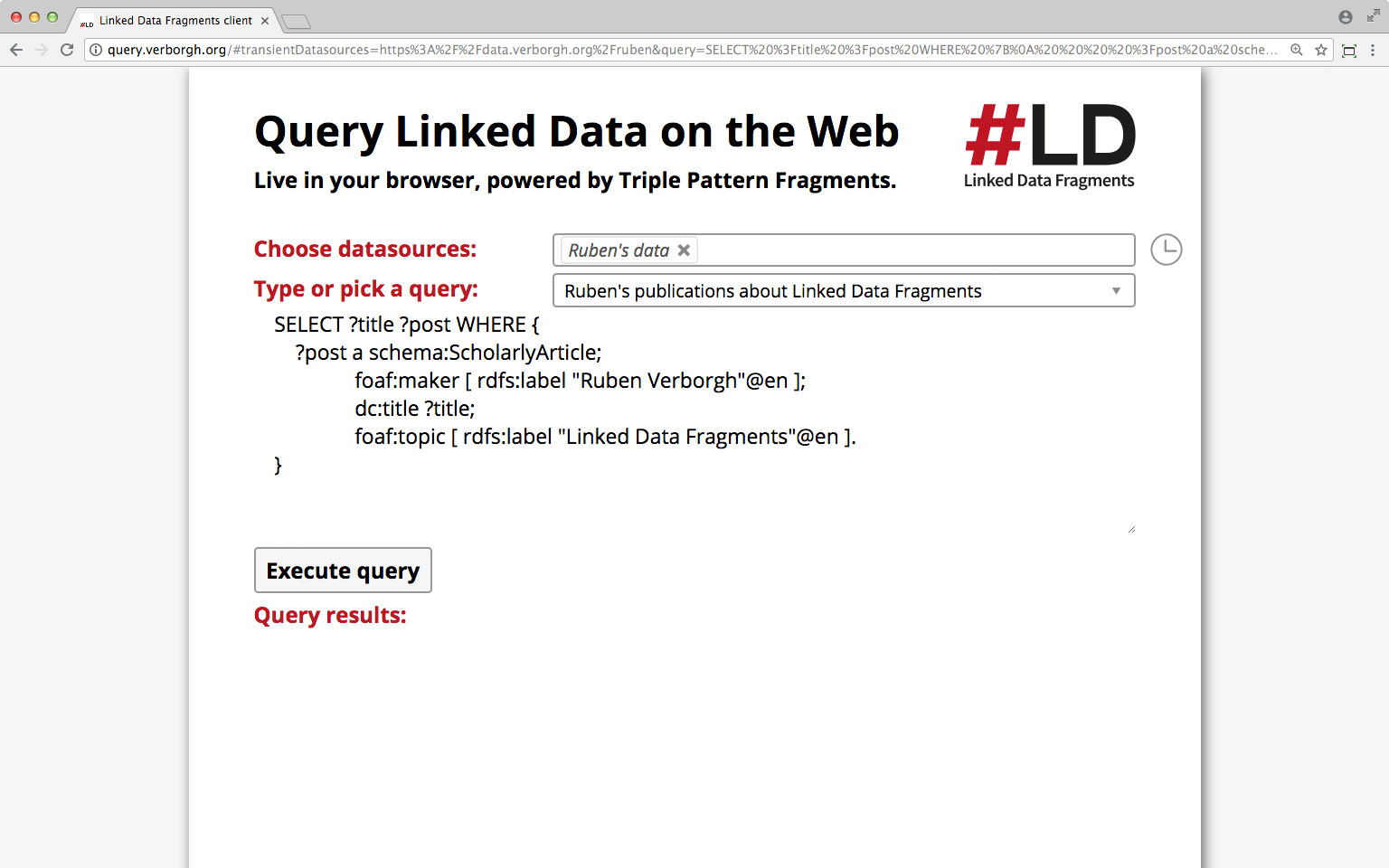The delicate dance of
decentralization and aggregation
Ruben Verborgh
Ghent University – imec
Why are we publishing
Linked Data again?
-
Linked Data provides a flexible data model.
- no more field overloading
-
Linked Data facilitates metadata integration.
-
Linked Data connects metadata across the Web.
- no single source of truth
Why are we publishing
Linked Data again?
-
We demand metadata ownership.
- Aggregators are allowed access—we remain the authority.
-
We have our own metadata priorities.
- We choose the vocabularies.
-
We cannot maintain all metadata ourselves.
- We link to other authorities.
Why are we publishing
Linked Data again?
-
Consumers can browse metadata.
- Show metadata for a specific subject.
-
Consumers can query metadata.
- Show a custom selection of metadata.
-
Aggregators can harvest metadata.
- Why is this still necessary?
Aggregators merge multiple collections
into a single centralized view.
-
They facilitate exploration across datasets.
-
Although currently a technical necessity,
aggregation comes with drawbacks.
- Are records up-to-date and complete?
-
Can/should every dataset be included?
- If so, how to guarantee quality?
- Where is the benefit for individual publishers?
Are we publishing Linked Data
only for the happy few?
-
If aggregation is a necessity for querying,
then only those with large infrastructures
can make sense of the Web’s Linked Data.
- They offer intelligence as a service.
-
We own (our part of) the data,
but not the intelligence around it.
Decentralization can be realized
at very different scales.

Every piece of data in decentralized apps
can come from a different place.

Solid is an application platform for
decentralization through Linked Data.
The creator represents each data item
as Linked Data.
PREFIX as: <https://www.w3.org/ns/activitystreams#>
PREFIX xsd: <http://www.w3.org/2001/XMLSchema#>
<#elag2018> a as:Like;
as:actor <https://ruben.verborgh.org/profile/#me>;
as:object <https://www.elag2018.org/#conference>;
as:published "2018-06-05T07:00:00Z"^^xsd:dateTime.
Others can learn about my data
through Linked Data Notifications.
PREFIX as: <https://www.w3.org/ns/activitystreams#>
PREFIX xsd: <http://www.w3.org/2001/XMLSchema#>
_:announce a as:Announce;
as:actor <https://ruben.verborgh.org/profile/#me>;
as:object <https://drive.verborgh.org/likes/#elag2018>;
as:target <https://www.elag2018.org/#conference>;
as:updated "2018-06-05T07:00:00Z"^^xsd:dateTime.
A Linked Data Notification is
posted to your inbox.
POST /inbox/ HTTP/1.1
Host: www.elag2018.org
Content-Type: text/turtle
HTTP/1.1 201 Created
Location: https://www.elag2018.org/inbox/3679efc35
If I place a comment,
you can choose to link back.
-
you will know about my comment
- if you advertise a notification inbox
- if I choose to notify you
-
you can see my comment
- if I give you access permissions
-
you can link back to my comment
- if you want to
- so others can discover it
Multiple decentralized Web apps
share access to data stores.

When visiting an application,
you log in with an external identity.
-
I go to https://example.org/app
-
I log in with https://ruben.verborgh.org/profile/#me
- giving the app permission to access (parts of) my data
-
The app requests data on my behalf
- from ruben.verborgh.org
- from my friend’s data pods
Different app and storage providers
compete independently.

Hard-coded client–server contracts are
unsustainable with multiple sources.

We have to manually contact sources
and hope that contracts don’t change.
const me = 'https://ruben.verborgh.org/profile/#me';
const profile = await fetch(me);
const triples = parseTurtle(await profile.text());
const friends = triples.findObjects(me, 'foaf:knows');
friends.forEach(friend => {
const profile = await fetch(friend);
const triples = parseTurtle(await profile.text());
// now find likes
});
Query-based contracts can make
decentralized Web apps more sustainable.

This query captures the same intent
independently of sources and interfaces.
PREFIX foaf: <http://xmlns.com/foaf/0.1/>
PREFIX as: <http://www.w3.org/ns/activitystreams#>
SELECT ?friend ?like WHERE {
<https://ruben.verborgh.org/profile/#me> foaf:knows ?friend.
_:like a as:Like;
as:actor ?friend;
as:object ?like.
}
We are building the Comunica engine
to support such query scenarios.
I have been publishing my own metadata
since before most of these existed.
-
The only correct publication record
is the one that I publish myself.
-
I am the source of truth
of my publication metadata.
-
I have one page of all my publications
and one page for each publication.
- All are semantically marked up.
-
I publish all of this as Linked Data.
Why spend time on this while
the aggregators already do?
-
They’re doing it wrong.
- incomplete
- incorrect
- inconsistent
-
I don’t have time to correct all of them
and keep them in sync.
- They will mess it up anyways.
I want to be the source of truth.
I don’t need to be the only source.
-
I have this recurring dream in which
all of these platforms just harvest my data.
-
They can have it for free—it’s CC0.
-
I almost wish I could pay
to give them the correct data.
-
I’d need to set up one-off integrations (if allowed)
and they would break every month.
My personal website contains metadata
about my research and publications.
This includes metadata for:
My data is published following
the Linked Data principles.
-
1 FOAF profile in Turtle
- partly manual, mostly autogenerated
- >8,000 RDF triples about myself, people, publications
-
260 HTML+RDFa pages
- autogenerated using 5 template pages
- >13,000 RDF triples about publications, blog posts, articles
- (±50 triples per page)
My data is modeled using several
ontologies and vocabularies.
- Friend of a Friend (FOAF)
- Schema.org
- Bibliographic Ontology (BIBO)
- Citation Typing Ontology (CiTO)
- DBpedia
I publish my own Linked Data because
we need to practice what we preach.
-
How can I convince people
they should publish 5-star Linked Data
if I’d make up excuses for myself?
-
My data is a home-cooking version
of Semantic Web Dog Food.
But who am I generating this data for?
-
Clearly, existing research networks don’t read it.
- …with the exception of Google Scholar.
-
Schema.org-compatible search engines
are probably very happy with it.
- They crawl and see the whole dataset.
-
We can’t build useful live applications on top of it.
- Linked Data clients only see small parts of the data.
The value of my Linked Data
needs to be unlocked.
I want to:
- help people consume my data
- lower the barrier for data reusers
-
enable powerful cross-dataset queries
Traversal-based Linked Data querying
cannot answer all questions adequately.
-
Completeness cannot be guaranteed.
- Web linking is unidirectional.
-
The vocabulary constructs in the query
are seldom identical to those of the data.
-
foaf:Person,
schema:Person,
or
wikidata:Q5?
-
rdfs:label,
dc:title,
foaf:name,
or
schema:name?
Open questions about
modeling Linked Data:
-
What ontologies should we use?
- …on webpages?
- …in a FOAF profile?
-
Should we describe the same concepts
using multiple ontologies?
-
Should we use generic properties and classes
or specific subproperties and subclasses?
Be conservative in what you send,
but literal in what you accept.
-
Interestingly, with Linked Data,
being conservative
does not mean limiting our vocabularies.
-
The lower the number of vocabularies you use,
the lower the chance the client knows any of them.
-
Represent the same data in multiple ontologies
to maximize client compatibility.
-
There will at least be one ontology it understands.
Solving querying fully at the server side
is too expensive for personal data.
- Hosting a SPARQL endpoint is expensive.
- A SPARQL endpoint with reasoning even more.
-
Marking up all data in two directions
and with multiple ontologies is unfeasible.
- difficult to maintain
- hard to express in RDFa Lite
I designed a simple ETL pipeline
to enrich and publish my website’s data.
This process runs every night:
- Extract RDF triples from
Turtle and HTML+RDFa documents.
- Reason over this data and its ontologies.
- Publish the result in a queryable interface.
Reasoning on the data and its ontologies
makes hidden semantics explicit.
We use forward-chaining reasoning
in a careful multi-step process.
- Skolemize ontologies to remove blank nodes.
- Compute deductive closure of ontologies.
- Compute deductive closure of ontologies and data.
- Subtract 2 from 3 to obtain only the enriched data.
- Remove leftover skolemized IRIs.
Reasoning expresses the same data
in different ways for different clients.
| | time (s) | # triples |
|---|
| extraction | 170 | 17,000 |
|---|
| skolemization ontologies | 1 | 44,000 |
|---|
| closure ontologies | 39 | 145,000 |
|---|
| closure ontologies & data | 62 | 183,000 |
|---|
| subtraction | 1 | 39,000 |
|---|
| removal | 1 | 36,000 |
|---|
| total | 273 | 36,000 |
|---|
Reasoning fills ontological gaps
before querying happens.
| | # pre | # post |
|---|
dc:title | 657 | 714 |
|---|
rdfs:label | 473 | 714 |
|---|
foaf:name | 394 | 714 |
|---|
schema:name | 439 | 714 |
|---|
schema:isPartOf | 263 | 263 |
|---|
schema:hasPart | 0 | 263 |
|---|
cito:cites | 0 | 33 |
|---|
cito:citesAsAuthority | 14 | 14 |
|---|
The resulting data is published
in a Triple Pattern Fragments interface.
-
A TPF server lets clients access RDF data
only by single triple patterns.
-
Full SPARQL queries are executed by clients.
-
TPF extends the Linked Data principles.
- Also offer predicate- and object-based lookup.
- Provide “dereferencing” of a URL on a different domain.
-
TPF interfaces are cheap.
- My server costs less than €5/month.
This is my personal data
in a Triple Pattern Fragments interface.
What scholarly articles did I write
about Linked Data Fragments?
What scholarly articles did I write
about Linked Data Fragments?
What scholarly articles did I write
about Linked Data Fragments?
What scholarly articles did I write
about Linked Data Fragments?
What scholarly articles do I cite
from within my publications?
What scholarly articles
do I agree with?
TPF query clients find all results
and find them faster.
| # results | time (s) |
|---|
| | LD | TPF | LD | TPF |
|---|
| people I know | 0 | 196 | 5.6 | 2.1 |
|---|
| publications I wrote | 0 | 205 | 10.8 | 4.0 |
|---|
| my publications | 134 | 205 | 12.6 | 4.1 |
|---|
| works I cite | 0 | 33 | 4.0 | 0.5 |
|---|
| my interests (federated) |
0 | 4 | 4.0 | 0.4 |
|---|
What topics am I interested in,
and what are their definitions?
What books by authors from Prague
are in Harvard Library?
The Paradox of Freedom:
you can only be free if you follow rules.
-
Decentralization means making our own choices.
-
Unless we agree on some basic things,
no one will see the result of our choices.
-
Agreement can be layered:
- 100% agrees on a small set (labeling, authorship, …)
- 80% agrees on a larger set (places, dimensions)
- 5% agrees on many smaller sets (sizes, colors, …)
We need to identify those rules
we all need to agree on.
- vocabularies
- data shapes
- interfaces
Lessons learned from aggregating hundreds of datasets
are highly useful to inform the discussion.
Fortunately, this is where
the semantics of Linked Data shine.
-
Linked Data contain meaning.
- We can easily transform from one ontology to another.
-
SPARQL queries contain meaning.
- One query works on multiple sources.
- One query works on multiple sources simultaneously.
Our metadata starts decentralized.
Why do we centralize via aggregation?
-
visibility and discovery
- data has higher chance of being found in an aggregator
-
quality
- aggregator can align data cross datasets
-
infrastructure
- only the aggregator needs complex software
What gets lost in translation
when data is aggregated?
-
Every collection has its own accents
and uniquely defining properties.
-
Aggregators expect some homogeneity
in order to realize their benefits.
-
Some of the properties with the most investments
are not reflected adequately.
What flows back to data producers
as a return from aggregators?
-
Do you receive the improvements
that were made to your metadata?
-
Can you leverage the connections
that were made with your data?
-
Do you receive additional data
that can help you improve?
Imagine all sorts of feedback
we are missing out on.
- What are people looking at most?
- What metadata fields do people use?
- What are people searching for?
This knowledge lets (only) you improve your data
and the experience of those who eventually use it.
Decentralization needs replication
for realistic performance.

In addition to technological changes,
we need a shift of mindset.
-
from the one
to one of many
-
from source
to station
-
from platform
to service
Current networks are centered
around the aggregator.

We need to create network flows
to and from the aggregator.

The individual network nodes
need to become the source of truth.

Aggregators need to become part
of a larger network.

Aggregators serve as a crucial
but transparent layer in the network.

Aggregators’ main responsibility becomes
fostering a network between nodes.






